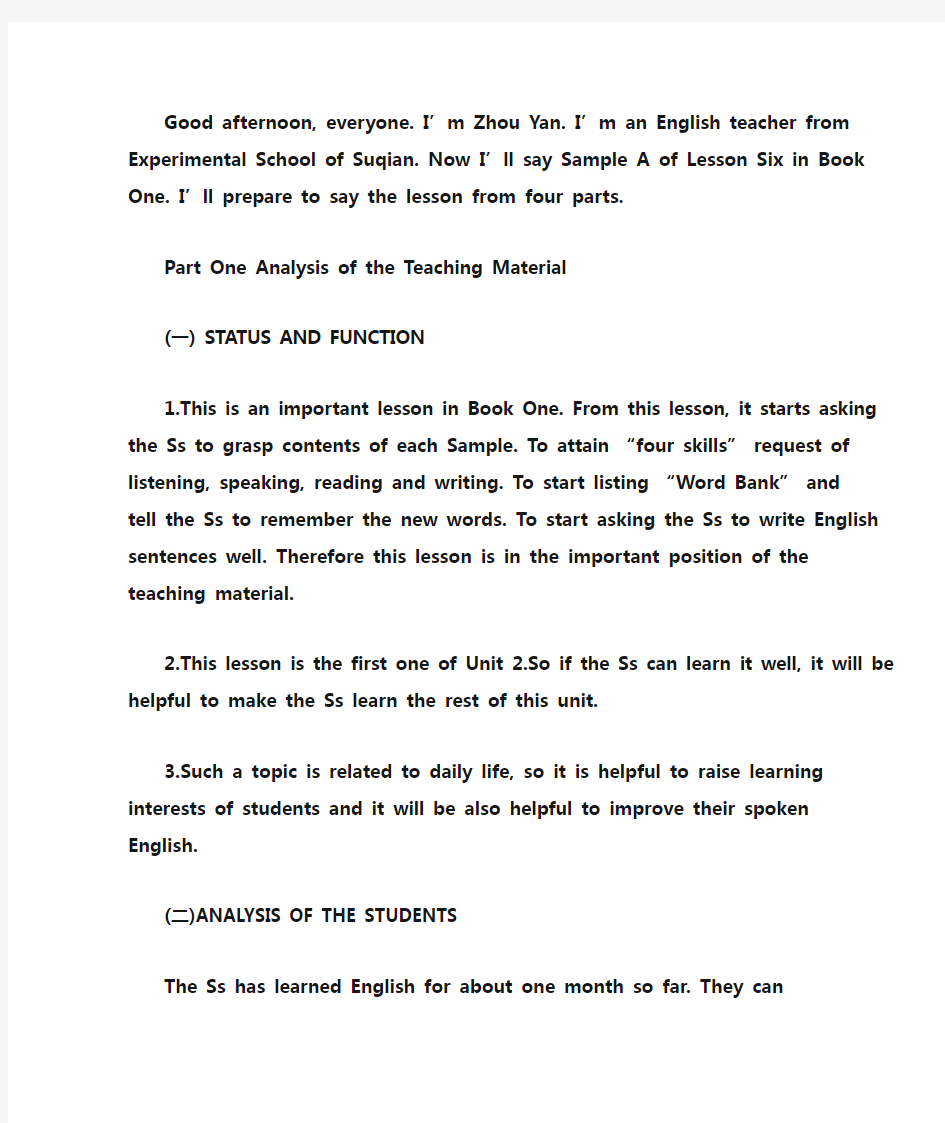
初中英语语法说课稿
- 格式:doc
- 大小:35.00 KB
- 文档页数:5


Good afternoon, everyone. I’m Zhou Yan. I’m an English teacher from Experimental School of Suqian. Now I’ll say Sample A of Lesson Six in Book One. I’ll prepare to say the lesson from four parts.
Part One Analysis of the Teaching Material
(一) STATUS AND FUNCTION
1.This is an important lesson in Book One. From this lesson, it starts asking the Ss to grasp contents of each Sample. To attain “four skills” request of listening, speaking, reading and writing. To start listing “Word Bank” and tell the Ss to re member the new words. To start asking the Ss to write English sentences well. Therefore this lesson is in the important position of the teaching material.
2.This lesson is the first one of Unit 2.So if the Ss can learn it well, it will be helpful to make the Ss learn the rest of this unit.
3.Such a topic is related to daily life, so it is helpful to raise learning interests of students and it will be also helpful to improve their spoken English.
(二)ANALYSIS OF THE STUDENTS
The Ss has learned English for about one month so far. They can understand some words and some simple sentences. The Ss have taken
a great interest in English now.
(三)TEACHING AIMS AND DEMANDS
The teaching aim's basis is established according to Junior School English syllabus' provision.
1.Knowledge objects
(1) To make the Ss know how to use the affirmative sentence “This
is. . . .” and the negative sentence “This is not….”Everyday expressions for “Apologies”“I\'m sorry”“That\'s all right”.
(2) To study the new words “six, hey, sorry, it’s, that’s”, etc. by learning the dialogue of this lesson.
(3) To finish some exercises.
2.Ability objects
(1) To develop the Ss’ abilities of listening, speaking, reading and writing.
(2) To train the Ss’ ability of working in pairs.
(3) To dev elop the Ss’ abilities of communication by learning the useful structures.
3.Moral objects
(1) To enable the Ss to be polite and love life.
(2) To enable the Ss to look after their things well.
(四)TEACHING KEY AND DIFFICULT POINTS
The teaching key and difficult points’ basis is established according to Sample A of Lesson Six in the teaching material\'s position and function.
1.Key points:
(1).To help the Ss to communicate with each other.
(2).To enable the Ss to study in groups and co-operate skillfully.
(3).To develop the Ss’ interest in English.
2.Difficult points:
(1) How to make dialogues and act them out.
(2) How to write the right whole sentences.
(五) TEACHING AIDS
Multi-media computer, Tape recorder, Software: Powerpoint or Authorware, school things and so on. They will be needed in this lesson. Part Two The Teaching Methods
1. Communicative teaching method
2. Audio-visual teaching method
3. Task-based” teaching method
As we all know: the main instructional aims of learning English in the Middle School is to cultivate students’ abilities of listening, speaking, reading, writing and their good sense of the English language. So in this lesson I’ll mainly use “Communicative” teaching method, “Audio-visual” teaching method and “Task-based” teaching method. That is to say, I’ll let the Ss to get a better understanding of the key structure of the dialogue. I’ll give the Ss some tasks and arrange five kinds of activities: talking, guessing games, watching CAI, acting out Sample A and having a competition.
Teaching special features
To use these methods are helpful to develop the Ss’ thought.
Part Three STUDYING WAYS
1.Teach the Ss how to be successful language learners.
2.Let the Ss pass \"Observation—Imitation—Practice \" to study language.
3.Teach the Ss how to master dialogues and how to communicate with others.
Teaching special features:
Let the Ss communicate with each other and adopt competition methods to develop the Ss’ keen interest in English.
Part Four Teaching Procedure
I’ll finish this lesson in four steps. First I’ll divide the Ss into four groups and bring a competition into the class. At last let’s see which group is the winner.
Step1 Warm-up
1. Free talk between T and Ss .
Such as: Hi, I’m . . . . What’s your name?
This is …. How do you do?
Who is he/she? How are you?